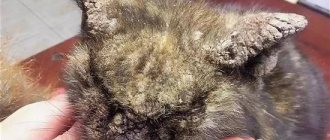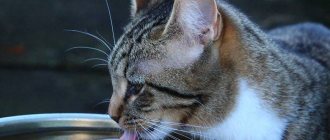Epileptic disease is a serious pathology of the nervous system, namely the brain. It manifests itself as seizures (or their equivalents). Epilepsy in cats is not one of the most common diseases, so its first symptoms take most owners by surprise. Awareness of the clinical picture and first aid skills during attacks is a necessary minimum for effective treatment and prevention of complications in a pet.
Epilepsy: what is it?
This term in medicine refers to a chronic neurological disease, which is associated with the body’s tendency to suddenly develop seizures. Its pathogenesis is based on paroxysmal discharges in the neurons of the brain. This disease is diagnosed when seizures recur with some regularity.
Epilepsy occurs not only in humans, but also in cats, dogs, and mice. This disease most often occurs in small animals. The prevalence of this pathology among representatives of the cat family is about 0.5–1%. This disease can manifest itself in any cat, both at an early and old age.
Life of a cat with epilepsy
What is life like for pets with such a terrible diagnosis for many people as epilepsy? Fortunately for the owners of such animals, even with such a disease, cats are able to live a long, fulfilling life and remain active. Of course, all this is possible with the right treatment. The primary form will require constant use of medications, which will impose certain restrictions on the pet’s life, but they will not prevent you from having a good time with him.
Caring for a cat with epilepsy will allow it to live a long and happy life.
What types of epilepsy are there?
There are several forms of epilepsy. They differ from each other in etiology and approach to treatment. To successfully rid a four-legged patient of convulsive seizures, the veterinarian first directs all knowledge and experience to determining the type of disease.
Detailed information about the types of epilepsy in cats and their characteristics is presented in the table:
| Form of feline epilepsy | Description | Peculiarities | Pathology prognosis |
| Congenital (real, idiopathic) | This congenital disease manifests itself in the pet at an early age. The disease can be the result of genetic abnormalities, impaired brain formation, and birth injuries to the head. | This type of disease is extremely difficult to diagnose. In most situations, it is not possible to determine the cause of its occurrence. This form of epilepsy accounts for 30% of all cases of detection of this disease. | Cannot be treated. In some cases, they resort to euthanizing the animal. |
| Acquired (false, secondary, symptomatic) | Develops as a result of endogenous and exogenous factors. | As a rule, pathology does not manifest itself immediately. | In most situations, once the root cause of the disease is eliminated, the seizures also stop. |
How is the diagnosis carried out?
If you witness an epileptic attack in a cat, be sure to contact your veterinarian. Thanks to timely diagnosis, the complications listed above can be avoided.
Examination of the animal and conversation with the owner
After a visual examination, temperature measurement, palpation of the abdomen and other basic manipulations, the veterinarian will need to collect an anamnesis, that is, all information related to the condition of the sick pet. This point is very important in making a diagnosis, so be sure to describe what happened in every detail, not forgetting to mention the duration of each stage and the events preceding them.
ADVICE!
If you see something unusual, shoot it on camera. Video recording will prevent you from missing an important point during a conversation with a doctor.
Separately describe all your pet’s chronic diseases, as well as those that have long been cured. If you have information about the cat's parents, you should also provide them.
Laboratory research
After collecting an anamnesis, clinical and biochemical tests of urine and blood are taken from the animal, as well as a blood sugar test. Based on their results, the presence of inflammation, intoxication, anemia, diabetes mellitus, as well as various abnormalities in the functioning of the liver and kidneys is determined.
Ultrasound and X-rays are used to check the functionality of major organs and systems, as well as hidden injuries. Brain functionality is checked using an electroencephalogram. If necessary, two more studies are added to the listed studies: CT and MRI.
REFERENCE!
In the absence of obvious causes of the pathology, the pet is diagnosed with “idiopathic epilepsy,” that is, primary.
First aid
The cat owner must be prepared for anything. During a seizure, you should act as follows:
- Place the animal on the floor to avoid falling and injury.
- Sit next to each other. Place your hand under your pet's head.
- Lay down a dense bedding to avoid hitting the floor.
- To prevent your cat from biting her lip, insert the tip of a spoon between her teeth.
- The tongue of a cat lying on its side will not stick into the larynx, so you should not push a spoon into its mouth or stick your fingers in.
Epilepsy in a cat
Features of caring for a sick pet
Because epileptic seizures occur suddenly, it is important to protect your sick cat by:
- do not allow sitting on open windows and loggias without supervision;
- do not let one out into the street;
- remove traumatic loose objects from the apartment;
- limit access to tall furniture (cabinets, tables, shelving);
- change your diet smoothly.
Try not to turn on bright lights or loud music in the presence of a cat. Do not play with the animal flashlight and laser pointer. Refrain from using New Year's flashing lights.
It is important to be attentive to changes in your pet’s behavior, not leave it alone for a long time and strictly follow the doctor’s advice, and do not skip taking medications.
Symptoms of the disease in cats: how does the attack proceed?
The disease in cats manifests itself in attacks, each of which occurs in several stages, characterized by different signs and different durations.
An epileptic seizure begins with a prodromal phase, then an aura occurs. The third stage of the attack, ictal, is the climactic stage. The seizure ends at the postictal stage. Information on the manifestations of this disease in cats is presented in the table:
| Stages of an epileptic seizure in cats | Symptoms | Duration |
| Prodromal | This stage is preparatory. The clinical picture at this stage of the seizure is blurred and individual in nature. During this period, most pets experience sleep disturbances, apathy, and partial or complete loss of appetite. Based on these signs, it is extremely difficult for a cat owner to determine the approach of an epileptic seizure. In some animals, this stage does not have pronounced manifestations and has almost no effect on their normal behavior. | From 2–3 hours to 2–3 days. |
| Aura | This stage represents an intermediate stage between the preliminary phase and the convulsions themselves. The aura is characterized by the severity of the clinical picture. When a pet enters this phase, many cat owners note that they are in a half-asleep, lethargic state. However, some animals, on the contrary, become too excited. An aura can be recognized by the following symptoms:
Shortly before a seizure, the pet sometimes becomes aggressive. Whenever you try to pick him up or stroke him, he shows hostility. | No more than 2–3 minutes |
| Ictal | This stage is the culminating stage - an epileptic attack occurs. Even a person who has never encountered such a phenomenon before can guess that a cat is having a seizure. It happens as follows:
During a seizure, a cat is capable of injuring itself to varying degrees of severity. This stage can proceed in different ways. In some animals, the listed symptoms occur once, in others - 2-3 times without a break. The latter condition poses a serious danger to the pet. | From 2–3 seconds to 5 minutes |
| Postictal | It is a mistake to think that an epileptic seizure ends with the ictal phase. In fact, the fact that the pet has regained the ability to control its body does not mean that it has returned to its normal state. Recovery from a seizure takes different times for different animals. After the ictal period ends, the cat may appear slightly clumsy. The symptoms of this phase depend on the nature of its occurrence. Pets that are characterized by a predominance of excitation over inhibition are in a lost state and confusion. They may become disoriented in a familiar space and begin to panic. Cats who have suffered an attack avoid contact with household members or behave aggressively, trying to attack anyone who approaches them. They move swaying, can often fall, bumping into corners and furniture, jump up abruptly and run around the house. Those pets in which inhibition prevails over excitation, at the postictal stage often do not differ from their healthy counterparts, because they do not have such pronounced symptoms as described above. However, less severe severity does not indicate a complete absence of pathological signs. This category of cats also suffers from the consequences of a seizure, but in them it is not as noticeable. | From several hours to several days. |
Features of external manifestation
The disease can be recognized by its external signs, which are typical. But only a doctor can make a direct diagnosis.
Forms of the disease
Cats can be diagnosed with congenital or acquired forms of epilepsy. Both forms are characterized by the same symptoms. The only differences are in the time of the first attack:
- with congenital epilepsy, the first seizures may appear at a young age;
- in the case of acquired - at any age, more often after a certain event in the cat’s life.
Congenital or true epilepsy
Another name for congenital epilepsy is idiopathic. This form of the disease is the result of improper development of the animal’s nervous system even before its birth. In this case, the processes of excitation and inhibition that occur in the cerebral cortex are performed incorrectly. There are no pathologies or concomitant diseases. The most likely reasons are:
- inbreeding;
- chronic infections and intoxication during pregnancy.
Factors that contribute to the development of congenital epilepsy are also identified:
- hormonal imbalances;
- endocrine diseases;
- heredity.
During diagnosis, no abnormalities are detected in urine, blood, or cerebrospinal fluid (CSF) tests.
Most often, the trigger is a hormonal surge during puberty.
Acquired or symptomatic
Unfortunately, disturbances in the functioning of the brain can occur at any stage of a cat’s life, which means that no one is immune from epilepsy. The symptomatic form may occur as a result of:
- traumatic brain injury;
- the appearance of various tumors in the brain;
- viral infections (most often the development of epilepsy is promoted by plague and rabies);
- lack of nutrition of B vitamins and vitamin D (they are responsible for the normal functioning of the nervous system), calcium and magnesium;
- poisoning with chemicals, medications, gases, toxins of viral or bacterial origin.
Stages of an epileptic seizure
There are three stages of development of an epileptic seizure:
- The stage of harbingers (“aura”). A short and not always noticeable stage of the attack. It manifests itself in different ways, for example, an animal can:
- suddenly become restless, afraid of everything;
- do not react to light or noise;
- tilting the head to the side, which can cause the muscles to twitch, making it difficult for the cat to maintain balance.
- The phase of seizures (ictal stage). At this stage, the muscles contract, which is why the paws twitch (and not necessarily all of them, only one of them can twitch), the animal may lose consciousness, control over urination, and foamy saliva is released from the mouth. The cat's breathing becomes intermittent, heavy, and can be clearly heard. The heartbeat also increases.
During an attack, your cat may produce foamy saliva.
- Recovery phase (postictal stage). After the seizures stop, the cat is in complete prostration; she does not understand where she is and does not recognize her owners. The duration of the recovery phase is about 5 minutes. Some cats attack food and water during this period.
The stages may be erased, the symptoms less pronounced. It all depends on the characteristics of the cat itself.
The duration of the attack is about 3–4 minutes. The frequency of each cat is different, it is difficult to predict when the next seizure will occur. But it is worth remembering that too frequent attacks can lead to death. This is because irreversible changes can occur in the brain due to insufficient oxygen.
Video: grand mal seizure
How it manifests itself
The first thing that comes to mind is, of course, cramps. But this is only one (albeit the most striking) manifestation.
The mechanism of the attack is divided into three phases, which differ in their characteristics.
The first is the stage of short-term precursors , which, due to its transience, may not be noticed. At this time, the cat becomes restless and seemingly absent-minded (does not react to sounds or light), perhaps even shy.
Having caught this moment, you will notice that the muscles begin to twitch slightly, and the head is tilted to the side - the pet briefly loses coordination.
The next phase involves more serious convulsions . They are easy to spot:
- the muscles begin to contract rapidly, and the paws begin to twitch;
- saliva and foam come out of the mouth in large quantities;
- breathing becomes intermittent (after listening, you can identify a clear synchronized wheezing or groan);
- heart beats faster;
- uncontrolled release of urine or feces is possible;
- in some cases it even reaches the point of loss of consciousness.
This picture can be observed for several minutes (or even half an hour), after which the recovery . This means that within 5 minutes after the peak of the exacerbation the animal will be very weak and a little “lost” - this phase is characterized by prostration and disorientation in a familiar environment. After the specified time has passed, the purr returns to normal and runs to the bowl to eat or drink water.
Did you know? Cats excrete sweat through their paws—unlike humans, they do not have sweat glands throughout their bodies.
Note that here is a classic list of the main symptoms and phases. In practice, the boundaries between stages are often blurred. The same applies to the frequency of the attack: it can be repeated several times a day or occur once a month.
In any case, owners should know what to do if their beloved cat’s epilepsy has reached its peak form.
Important! Any attack, regardless of its duration, can be a reason to visit a doctor. Even a convulsion of a few seconds, if repeated frequently, will result in a lack of oxygen for brain cells.
Is it possible to predict an epilepsy attack?
Often, animals begin to behave strangely before a seizure. They may be frightened by noises or loud sounds, look into emptiness and seem to fall out of reality.
Seizures are the main manifestation of epilepsy. They can be focal or generalized. Focal seizures refer to rapid, jerking movements of a specific part of the body (sort of like a mild version of seizures in cats).
In a generalized seizure, four phases of the preepileptic state are distinguished.
- At first, within 2-3 days, the animal experiences anxiety, it begins to be afraid of simple things - this is the prodromal phase.
- In the second phase, the cat begins to react inadequately to sounds and light; it lasts up to half an hour. Coordination is impaired, and muscles may noticeably contract.
- In the third, convulsive phase, the seizure itself begins. At the same time, the animal falls to the floor, arches, its paws begin to move quickly, and its jaw “shakes.” The cat's fur stands on end, breathing quickens, and foam may appear in the mouth. The animal does not control itself, which may cause spontaneous urination or excretion of feces.
- After the attack has stopped, the postictal phase begins - the animal comes to its senses, or, conversely, switches off. It may be frightened of the owner, looks weak and exhausted. The pet can recover up to 4 days.
Causes of epilepsy
Congenital and acquired epilepsy in representatives of the cat family is provoked by various factors. Causes of the first form of the disease:
- cat infection during pregnancy;
- intoxication of the baby’s body during intrauterine development;
- heredity – it is believed that this disease can be inherited;
- inbreeding (crossing of closely related individuals);
- birth head injury.
The second form of the disease can develop against the background of:
- traumatic brain injuries resulting from a fall from a height, bruise;
- neoplasms in the brain;
- infectious processes of viral and bacterial etiology;
- pathologies of internal organs (heart, blood vessels, liver, kidneys);
- poisoning with drugs, household chemicals, etc.;
- long stay in a stressful situation;
- deficiency of calcium, magnesium, vitamins B and D;
- metabolic disorders in the body.
Why is epilepsy dangerous?
Epilepsy is a signal that significant negative changes are occurring in the pet’s body.
The main danger of the disease is uncontrolled convulsions, due to which the animal can:
- hit hard;
- bite your tongue;
- start to choke;
- choke on saliva.
If the attack begins on the street, the cat may get hit by a car, fall from a height (for example, from a tree), or be attacked by dogs.
One-time, less often regular seizures are possible. If a cat remains unconscious for a long time, then refuses water and food, becomes very weak, and without proper assistance, there is a possibility of the pet’s death.
Prevention
What should be done for preventive purposes:
- Vaccinate kittens against diseases that can cause epilepsy.
- Protect the animal from contact with poisonous and toxic substances as much as possible. Including chemicals for cleaning the apartment.
- Do not leave your pet unattended.
- It is worth protecting your pet from stressful situations. For example, collisions with a dog.
All this cannot give an absolute guarantee that epilepsy will bypass the cat, but it will help to significantly reduce the risk of developing the disease.
Prevention of epilepsy
As mentioned above, there are many causes for epilepsy.
In order to protect your pet from possible epilepsy, you can do the following:
- Carry out regular vaccinations;
- Do not leave dangerous drugs or chemicals unattended and within the reach of the cat;
- Monitor your pet's behavior;
- Do not let her out onto the balcony, make sure there are no serious falls or injuries;
- Try to protect yourself from stress.
Epilepsy is a phenomenon that can affect your pets of any gender and age. Therefore, it is extremely important to care for the animal, provide it with adequate nutrition and physical activity, consult a doctor in a timely manner and, most importantly, create a positive atmosphere at home.
Which cats are at risk?
A direct connection of this pathology with specific cat breeds cannot be traced, however, according to statistics, epilepsy is more often detected in representatives of exotic cat breeds than other cat breeds. In addition, male pets are more susceptible to this disease.
Kittens do not have attacks of the disease at an early age. Seizures, if we are talking about a congenital form of the disease, appear no earlier than the animal is 5 months old.
First aid for an epileptic seizure
Short-term attacks, especially if they are relatively rare (occur no more than once a month), are not so dangerous for a cat. An animal can cause the greatest harm to itself during convulsions. Therefore, at the first signs (it is advisable to notice the beginning of a seizure even in the warning phase), the cat must be removed from any height (window sill, shelf, back of a sofa, etc. - if it is there) and placed in an open space, there should not be any sharp objects around or hard objects so that the pet is not injured during a seizure. Do not press the cat to the floor or put your fingers in its mouth, trying to fix the tongue. Firstly, it is useless - it will not stop the convulsions, and the animal will never swallow the tongue if it is positioned to the side. Secondly, a cat in a state of seizure can accidentally injure its owner.
Diagnosis of the disease
At the slightest suspicion of this disease, it is recommended to show your pet to a veterinarian as soon as possible. The following information will help your doctor make a diagnosis much easier:
- Detailed description of the attack. It is important not only how exactly the seizure occurred, but also how long it lasted and what events preceded it. If possible, it is recommended to record the attack on camera.
- Information about all the diseases that the cat has ever had, as well as preventive procedures performed (vaccinations, deworming). In order not to miss important information, you need to take your pet’s passport with you to the veterinary clinic.
- Data on the health characteristics of the four-legged patient’s parents, if available. If the owner of a purebred cat maintains contact with the cattery or breeder from whom she was purchased, it is recommended to try to find out whether her ancestors had epilepsy.
What to do if your cat has an epileptic seizure? How to stop epilepsy attacks?
- One of the most important points is to remain calm. Panic and fear will not allow you to act quickly. Remember that the life and health of your furry friend depends on your actions. People do not die from epilepsy attacks (only as a result of falling).
- Do not try to hold the animal, as you will harm either yourself or the cat.
- If at the time of the attack the cat is on a windowsill/stairs or other elevated surfaces, lower it to the floor with something soft underneath. This will reduce the risk of injury from falls.
- Remove everything unnecessary from the floor, try to cover sharp edges and corners with something soft so that the cat does not hit them.
- Reduce noise, ask everyone to leave the room, turn off the TV, don't talk yourself. Any noise can only provoke a further attack.
- Do not try to open your mouth or insert your hand or other object to prevent your tongue from sticking out. It’s better to turn the cat’s head on its side with a thick towel, so it definitely won’t get stuck.
IMPORTANT: Do not put anything into the animal’s mouth: spoons and other hard objects can break your pet’s teeth, and he will unintentionally bite the finger that you try to put in his mouth. And you can open your teeth only after the seizure is over.
No matter how seditious it may sound, videotape the process. This will help your veterinarian understand the cause of the seizure and prescribe the necessary treatment.
After the attack has passed, call your doctor for advice. If you are concerned about the condition of your pet, it makes sense to go to the clinic.
Particularly dangerous is the so-called “status epilepticus” - when seizures lasting more than 5 minutes occur in a series, and the cat does not even have time to come to its senses.
Treatment of epilepsy in cats
Treatment of this pathology is carried out at home. To stop seizures in a cat, in most situations it is enough to stop the signs of the underlying disease. If an idiopathic form of epilepsy is identified or the root cause cannot be eliminated (brain tumor, liver cirrhosis), there is a need to use anticonvulsant drugs (Diazepam, Phenobarbital, Pregabalin, Gabapentin), the dosage and duration of use of which is determined by the veterinarian in each specific situation.
With a mild course of the pathology and rare convulsive attacks, the use of anticonvulsants may not be necessary. In this case, taking sedative medications, such as Corvalol or valerian, will be sufficient.
In addition to drug therapy, correction of the animal’s nutrition is necessary. There are special foods for epileptic cats. When feeding your pet natural food, it is recommended to reduce the content of carbohydrates and grains in the cat's diet to a minimum, and also increase the amount of protein.
Advice from veterinary neurologists
Experienced veterinary neurologists, based on their knowledge and their own long-term experience, share very valuable advice:
1There is no danger to the pet’s life if the cat does not lose consciousness during an epileptic attack. Despite this fact, examination at a veterinary center is still necessary. 2If a cat experiences fainting, the veterinarian who is observing the tailed patient prescribes anticonvulsants. It is recommended to take such drugs from 4-5 months to life, although the final verdict depends on the doctor. 3It is unacceptable to self-medicate using dubious knowledge acquired on forums or heard in casual conversations. 4Every living creature’s body is individual and reacts differently to the symptoms of the disease and to treatment methods. Therefore, an individual approach is required for each individual cat diagnosed with epilepsy; if this is not taken into account, irreparable harm can be caused to the pet’s health.
Epilepsy in cats is an extremely serious disease, but it can be controlled. The main thing is to contact a veterinary center at the first symptoms and use the help of specialists in this profile. There is no way you can do tests and ultrasound examinations at home on your own. To avoid making your cat suffer without the necessary help, entrust its health to experienced veterinarians.
Types of epileptic seizures
Localized attack:
- twitching of the muscles of the muzzle;
- twitching of one of the body parts;
- Nervous blinking or swallowing.
Generalized seizure – includes all the symptoms of epilepsy:
- involuntary urination, defecation;
- foam at mouth;
- wheezing;
- whole body spasms;
- stopping breathing.
A reactive attack is not systematic. It manifests itself as a reaction to medications that are not suitable for the animal.
When to start treatment
There is no effective treatment. Success depends on the health of the animal.
If an epileptic attack in a cat was caused by the prescription of a medication that did not suit him, then the treatment regimen is simple:
- identify which medicine you are allergic to;
- stop taking the drug;
- taking Corvalol daily (the dosage is calculated by the doctor);
- monthly examination by a specialist.
Drug treatment involves taking medications at the same time every day, often throughout life, to prevent an epileptic seizure from occurring.
List of drugs for the treatment of epilepsy in cats:
- phenobarbital – reduces the frequency of seizures;
- hapabentin - stops brain signals, thereby stopping convulsive contractions;
- libromed - used for complex cases of epilepsy.
Home treatment after an epileptic attack is the best thing you can offer your pet. Under no circumstances should you try to calculate the dose of the drug yourself.
Treatment of epilepsy in cats with folk remedies
Herbal decoctions and unknown substances can trigger a recurrent attack. The cat should be treated only with medications selected by a specialist.
Features of the treatment of epilepsy in pregnant cats
Treatment should be exactly the same as for a non-pregnant cat. Pregnancy with epileptic seizures can cause swelling of the brain, which will lead to the death of your pet. Increased attention and monitoring of the cat's condition is required. Observation by a specialist and taking medications strictly on time.
Cats suffering from epilepsy are not allowed to become pregnant.
Gluten-free diet
You can switch your cat to a high protein diet. Products high in carbohydrates and gluten are excluded from the animal’s diet, as they are causative agents of nervous activity in the brain.
Food for epileptic cats
A veterinarian will select food high in protein for your pet. A low-carbohydrate diet may help reduce the frequency of seizures or stop them altogether.
Is the disease life-threatening for your pet?
Does the disease threaten the pet’s life? Epilepsy does not pose a threat to life, although it significantly complicates it. It is up to the owner to select medication and food to provide the cat with a comfortable life.
Prevention of epileptic seizures in pets
- animal vaccination;
- creating a non-traumatic environment for the cat;
- examination by a veterinarian once every six months.
Epilepsy is a cat disease that is not age-related. The main condition for the success of preventive measures is attention to the pet and monitoring its health.
Treatment
Treatment for epilepsy depends on its form. For primary epilepsy, special anti-epileptic drugs are prescribed, which are often intended for lifelong use. Secondary epilepsy involves recognizing the disease that causes seizure activity and then combating it. For example, in case of liver pathologies, the veterinarian treats the liver; in case of problems with blood vessels, the veterinarian focuses on the blood vessels.
Primary
Before treating true epilepsy, the pet owner must understand that this pathology cannot be completely cured. In the primary form of epilepsy, only maintenance therapy is possible, maximally relieving symptoms and shortening periods of convulsive activity.
For primary epilepsy, the cat is prescribed anticonvulsant medications.
Medicines
The drug options that veterinarians prescribe for most animals with epilepsy are listed in the table.
Table 1. Anti-epileptic drugs for cats
| A drug | Description |
Phenobarbital | The medication is the most popular remedy in the fight against epilepsy. Effective in reducing the frequency of seizures. Among the negative aspects of the drug, one can note a pronounced sedative effect and a negative effect on the general emotional state of the pet. Some owners have noted an increase in irritability in their cats with periodic use of Phenobarbital. This drug also sometimes helps increase appetite. |
Libromide | The medication is used to combat the most severe attacks of epilepsy in animals. The drug is non-toxic and does not inhibit liver function. Among the side effects can be identified drying of the skin, most clearly manifested in the appearance of cracks on the cat’s nose and paw pads. Used in both combination and mono therapy |
Gabaletin | The medication is aimed at reducing the production of neurotransmitters, which leads to a significant reduction in “extra” signals sent by the animal’s nervous system, leading to seizures. The exact dosage of the medication should be obtained from your veterinarian. On average, per kilogram of animal weight there are from 5 to 10 milligrams of the substance, given to the pet once every half day. Side effects are rare and include poor coordination and constant drowsiness. |
Zonisamide | An anticonvulsant medication that reduces the number of seizures by reducing the severity of synchronized neural excitation. Used by both animals and people. Designed for a long period of treatment with a gradual reduction in dosage |
Features of therapy
Since complete relief from seizures is impossible, the result that is considered positive is one that reduces the number of seizures by fifty percent or more. Also, the effectiveness of treatment will be manifested in a reduction in the severity of symptoms, a reduction in the phases preceding the immediate attack and the phases following it.
Properly selected therapy helps to increase the interval between attacks
In cases where long-term treatment does not give a satisfactory result, the veterinarian reviews the selected drug support regimen. The main reasons for the failure of therapy are the following:
- incorrect diagnosis;
- incorrect dosage of a particular drug;
- incompatibility of medications selected for combination therapy;
- premature addiction to the drug or intolerance to it.
The owner of an animal with epilepsy must clearly understand that making adjustments to the medications prescribed by the veterinarian and their dosage is strictly prohibited. Such actions can lead to a sharp deterioration in the animal’s condition and other unpredictable consequences.
During treatment, it is important to adhere to precise dosages of drugs
Reducing the prescribed dose is possible, as a rule, only after a year of successful treatment with stable positive results. Further, if your cat looks healthy and feels well, it is strictly prohibited to decide on your own to stop taking medications.
Forecast
The results of treating animals with epilepsy depend on the factors that led the pet to this disease:
- with primary epilepsy, the prognosis is positive, but cautious, since much depends on correctly selected therapy and its compliance by the owner;
- with secondary epilepsy caused by treatable diseases, the prognosis is positive. As a rule, when the disease that provokes epilepsy is cured, the attacks themselves disappear;
- with secondary epilepsy caused by pathologies that themselves pose a serious threat to the life of the cat, the prognosis is often unfavorable. Such pathologies include malignant tumors of the brain, severe systemic diseases (such as Addison's disease) and developmental abnormalities of the brain.
Prognosis for epilepsy depends on its course
Helping an animal during a seizure
During an attack, the cat may be injured. Following a number of rules will help to avoid this:
- When a seizure is approaching, you should try to create a quiet and calm environment in the house. It is recommended to close the curtains and dim the brightness. It is strictly forbidden to shout at your pet or use physical force against it. This will only worsen his condition.
- Place the cat in a position lying on its side on a flat horizontal surface (preferably the floor) to prevent it from falling from a height. It is recommended to cover the place where the pet lies with a sheet or oilcloth.
What an owner should do during a pet seizure
When the owner witnesses an epileptic seizure , he must be prepared for this and be aware of how to behave at this time:
1You should not touch the cat during a seizure; it can scratch or cling with its teeth; it is almost impossible to release such a grip before the seizure ends. 2 Any strong smell or noise can prolong the duration of the attack, since the animal’s psyche is tense to the limit. 3If a seizure occurs in the room where it occurs, it is recommended to turn off the lights or close the curtains, but it is better to leave the room yourself. 4It is necessary to place something soft around the cat, for example, pillows, in order to avoid injury; it would be good, upon noticing the approach of a seizure, to immediately place the sick pet on the floor, covering it with soft objects. 5The misconception is that during an attack you need to fix your tongue. If the animal lies on its side, then suffocation cannot occur.
In order to understand and study all the nuances of handling a cat during an epileptic seizure, you need to listen to advice and instructions from a veterinarian, read relevant literature, and best of all, watch a video on this topic, which will clearly show the correct position of the pet’s body during an attack.
Even if the cat feels well, it should not be left alone outside and its exposure to nature should be limited. For safety reasons, it is recommended to keep a pet with epileptic problems in an apartment or house under supervision. If the unexpected happens, you can contact our veterinary emergency center and order an urgent call at any time of the day; a veterinarian will arrive within 40 minutes.
What is status epilepticus?
Epilepsy itself cannot cause the death of a pet. A serious danger to the life of an animal is status epilepticus - a condition in which convulsive seizures are repeated one after another, and between them the cat does not have time to regain consciousness. Epistatus is dangerous because it leads to a serious load on the brain, as a result of which the pet develops severe neurological disorders and significantly reduces life expectancy. This condition requires immediate surgical intervention. Ignoring it inevitably leads to the death of the animal.
Emergency call to the veterinarian
Epilepsy is not a life-threatening condition. The danger lies in the injuries that a cat can receive during an attack, for example, falling out of a window, hitting the leg of a chair, etc. Therefore, the main goal of the owner’s actions is to prevent them.
But there is a concept of status epilepticus, which requires emergency contact with a veterinarian. This condition is characterized by several attacks in a row, between which the animal does not have time to recover. In the absence of veterinary care, each subsequent attack can cause:
- changes in brain tissue that are irreversible;
- asphyxia;
- hypothermia (a decrease in body temperature to a level insufficient to maintain normal functioning of the body);
- acidosis (increased acidity);
- heart failure.
Seek veterinary help immediately if:
- the duration of the attack is 5 minutes or more;
- the number of seizures has increased;
- the interval between attacks is too short (status epilepticus).
Symptoms
An epileptic seizure develops according to the following scenario:
- Precursor phase. The animal becomes timid, its head tilts to the side. The muscles twitch.
- Seizure phase. Lasts 3...40 minutes. Proceeds in the following sequence:
- The cat gets worried and suddenly falls on its side.
- The paws and mandible convulse.
- The eyes glaze over.
- Excessive salivation develops.
- The paws become hard.
- The excrement is separated.
- The recovery phase is accompanied by weakness. In five minutes the cat comes to its senses.
Symptoms of epilepsy
Epilepsy seizures in cats occur in 3 stages, respectively, each stage has its own symptoms. At the same time, both congenital and acquired forms of epilepsy proceed in approximately the same way.
1. Precursor phase
The cat, for no apparent reason, falls into a state of anxiety, fearfulness appears, the reaction to external stimuli is lost, the head begins to tilt to the side, and the muscles twitch slightly, making it difficult for the animal to maintain body balance. Cats in this state often make loud, strange noises. This phase lasts no longer than 10 minutes.
2. Seizure phase
Types of epilepsy
Depending on the reasons that caused the pathology, epilepsy in a cat is divided into:
- Congenital (idiopathic). The causes of the congenital form of the disease are difficult to diagnose. The disease accompanies the animal throughout its life. Over time, without proper treatment, the severity and duration of attacks may increase. The cat requires lifelong monitoring and supportive care.
- Acquired (symptomatic). Seizures in cats are a consequence of head injuries or a complication of other diseases. If the root cause is identified and treated adequately, the animal has a high chance of recovery.
Drug treatment
Treatment of epilepsy in cats with drugs must be agreed with a veterinarian. If attacks are rare (no more than one per month), medications are not required. In other cases, specific medications with anticonvulsant effects, magnesium preparations, and B vitamins are prescribed.
The dose is selected individually. The drugs are taken for a long time (in the case of idiopathic epilepsy - lifelong therapy). Unauthorized cessation of treatment is fraught with progression of the pathology.
In case of secondary epilepsy, the cause that provoked the disease is eliminated: the tumor is removed, the infectious disease is treated, and the metabolism is corrected.
The joint efforts of the owner and the veterinarian significantly improve the quality of life of a sick animal.










